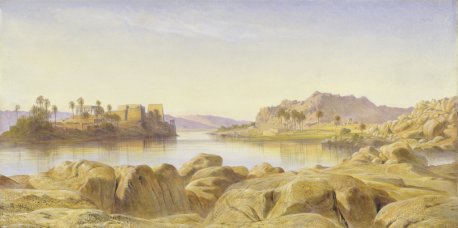Philae, Egypt
Overview
Philae, Egypt [ edit ]
Perhaps best known as a writer of nonsense verse, Edward Lear was also an accomplished landscape painter who journeyed to Egypt at least five times between 1849 and 1872. Lear was an inveterate traveler, in large part due to his ill heath: in addition to being an epileptic, he suffered from asthma and bronchitis, which were greatly exacerbated by the damp English climate. On returning from his first visit to the Middle East, in 1849, Lear expressed the aim of establishing himself as a painter of remote and unusual places. Until this point he had been self-taught, but in 1852 he met the Pre-Raphaelite artist William Holman Hunt, who was to have a profound effect on his art, providing Lear with technical advice on oils and demonstrating his techniques over the course of a summer spent painting together at a rented farmhouse in Sussex. Hunt’s influence can be clearly seen in this view of Philae, with its inclusion of mauves, pinks, oranges, and bright, vibrant greens. Philae was a favorite site for Lear, who produced at least twenty oil paintings of the island; the island was also a popular subject for Orientalist painters who traveled to Egypt, including David Roberts (“The Island of Philae,” 1843) and Lord Frederick Leighton (“The Temple of Philae”, 1868).
For this work, Lear has chosen a distant view of the island of Philae, enabling the artist to capture the wild and sublime landscape of the First Cataract, the rocky barrier of the Nile that divided ancient Egypt from Nubia. On the island itself, Lear has delineated the two sets of pylons of the temple of Isis, and to the left of the temple is the Kiosk of Trajan (“Pharaoh’s Bed”), one of the most distinctive features of Philae’s architectural ensemble (Catalog—Kiosk of Trajan). The construction of successive dams at Aswan during the first half of the Twentieth Century flooded the temples of Philae Island for most of the year, and the Aswan High Dam would have doomed the monuments to complete destruction. An international effort during the 1970’s moved the entire ensemble to the nearby island of Agilkia, a tourist destination that continues to inspire marvel to this day.
Date
1863
Dimensions
10 13/16 x 21in
Artist or Author
Edward Lear (1812-1888)
Provenance
British
Material
Oil on Canvas
Museum
Yale British Art Center
Accession Number
B1974.3.12
Herman De Meulenaere, Patrick Berko, and Viviane Berko, Ancient Egypt in Nineteenth Century Painting (Knokke-Zoute, Belguim: Berko, 1992).
Noakes, Vivien. “Lear, Edward (1812–1888),” Oxford Dictionary of National Biography. Oxford: Oxford University Press, 2004. Accessed July 2, 2012.
http://www.oxforddnb.com/view/article/16247.








